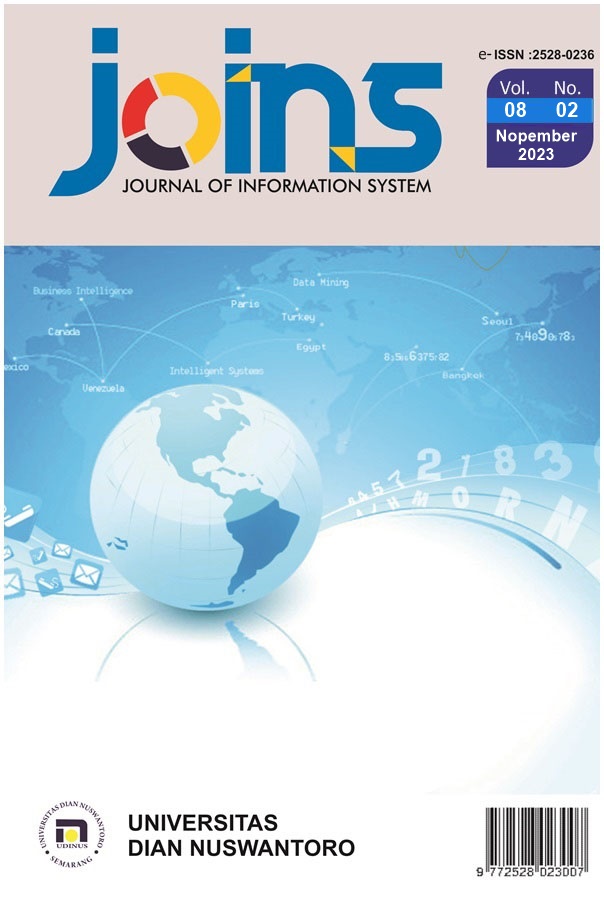Perbandingan Metode Peramalan ARIMA dan Single Exponential Smoothing pada Kasus Kejadian Demam Berdarah Dengue di Kota Semarang
DOI:
https://doi.org/10.33633/joins.v8i2.9335Keywords:
Demam Berdarah Dengue, Peramalan, ARIMA, Single Exponential SmoothingAbstract
Demam berdarah dengue (DBD) merupakan masalah kesehatan yang signifikan di Indonesia, khususnya di Kota Semarang. Setiap tahunnya, terdapat tren peningkatan penderita demam berdarah. Jika pemangku kepentingan tidak melakukan tindakan dan kebijakan preventif, hal ini akan berdampak buruk pada kesehatan dan kesejahteraan masyarakat. Peramalan kasus di masa yang akan datang merupakan salah satu upaya pencegahan dan pengendalian penyakit DBD. Penelitian ini menggunakan teknik peramalan ARIMA dan Single Smoothing Exponential. Data time series yang digunakan adalah bulan Januari sampai dengan Desember 2022 berdasarkan kasus kejadian di tingkat kecamatan Kota Semarang. Hasil percobaan kedua metode tersebut kemudian dibandingkan untuk mencari hasil terbaik dalam memprediksi jumlah kasus DBD di Kota Semarang. Hasil penelitian menunjukkan bahwa metode ARIMA memberikan hasil terbaik, dengan nilai MSE dan MAE yang lebih kecil.References
J. J. S. Cakranegara, “Upaya Pencegahan dan Pengendalian Penyakit Demam Berdarah Dengue di Indonesia (2004-2019),” J. Penelit. Sej. Dan Budaya, vol. 7, no. 2, p. 479401, 2021.
F. A. Ciptono, M. Martini, S. Yuliawati, and L. D. Saraswati, “Gambaran Demam Berdarah Dengue Kota Semarang Tahun 2014-2019,” J. Ilm. Mhs., vol. 11, no. 1, pp. 1–5, 2021.
A. Q. Munir and A. K. Sari, “Sistematic Review: Model peramalan wabah penyakit demam berdarah,” in Seminar Nasional Aplikasi Teknologi Informasi (SNATI), 2015.
C. Kirana, A. Zainuddin, and A. Asriati, “Evaluasi Pelaksanaan Program Pencegahan Dan Penanggulangan Penyakit Demam Berdarah Dengue Di Kota Kendari,” J. Ilm. OBSGIN J. Ilm. Ilmu Kebidanan Kandung. P-ISSN 1979-3340 E-ISSN 2685-7987, vol. 14, no. 3, Art. no. 3, Sep. 2022, doi: 10.36089/job.v14i3.835.
M. Mistawati, Y. Yasnani, and H. Lestari, “Forecasting prevalence of dengue hemorrhagic fever using ARIMA model in Sulawesi Tenggara Province, Indonesia,” Public Health Indones., vol. 7, no. 2, Art. no. 2, Jun. 2021, doi: 10.36685/phi.v7i2.411.
F. Fahrunnisa, N. Manurung, and R. A. Dalimunthe, “Peramalan Kasus Baru Penderita Hipertensi Di Kecamatan Rawang Panca Arga dengan Teknik Single Exponential Smoothing,” J-Com J. Comput., vol. 1, no. 3, pp. 237–244, 2021.
R. Kushartanti and M. Latifah, “Autoregressive Integrated Moving Average (ARIMA) Sebagai Model Peramalan Kasus Demam Berdarah Dengue,” J. Kesehat. Lingkung., vol. 10, no. 2, Art. no. 2, Oct. 2020, doi: 10.47718/jkl.v10i2.1165.
S. Siamba, A. Otieno, and J. Koech, “Application of ARIMA, and hybrid ARIMA Models in predicting and forecasting tuberculosis incidences among children in Homa Bay and Turkana Counties, Kenya,” PLOS Digit. Health, vol. 2, no. 2, p. e0000084, 2023.
A. Kharmayana Rubaya, H. Kusnanto, L. Lazuardi, and T. B. T. Satoto, “ARIMA Models of Dengue Cases in Kartamantul, Based on Area Risk Classification,” J. Medicoeticolegal Dan Manaj. Rumah Sakit, vol. 7, no. 2, 2018, doi: 10.18196/jmmr.7264.
C. M. Gibran, S. Setiyawati, and F. Liantoni, “Prediksi Penambahan Kasus Covid-19 di Indonesia Melalui Pendekatan Time Series Menggunakan Metode Exponential Smoothing,” J. Inform. Univ. Pamulang, vol. 6, no. 1, p. 112, Mar. 2021, doi: 10.32493/informatika.v6i1.9442.
E. Munarsih and I. Saluza, “Comparison of exponential smoothing method and autoregressive integrated moving average (ARIMA) method in predicting dengue fever cases in the city of Palembang,” J. Phys. Conf. Ser., vol. 1521, no. 3, p. 032100, Apr. 2020, doi: 10.1088/1742-6596/1521/3/032100.
B. Long, F. Tan, and M. Newman, “Forecasting the Monkeypox Outbreak Using ARIMA, Prophet, NeuralProphet, and LSTM Models in the United States,” Forecasting, vol. 5, no. 1, Art. no. 1, Mar. 2023, doi: 10.3390/forecast5010005.
R. Rachmat and S. Suhartono, “Comparative analysis of single exponential smoothing and holt’s method for quality of hospital services forecasting in general hospital,” Bull. Comput. Sci. Electr. Eng., vol. 1, no. 2, pp. 80–86, 2020.
N. G. Reich, J. Lessler, K. Sakrejda, S. A. Lauer, S. Iamsirithaworn, and D. A. T. Cummings, “Case Study in Evaluating Time Series Prediction Models Using the Relative Mean Absolute Error,” Am. Stat., vol. 70, no. 3, pp. 285–292, Jul. 2016, doi: 10.1080/00031305.2016.1148631.
Downloads
Published
How to Cite
Issue
Section
License
Authors who publish with this journal agree to the following terms:
- Authors retain copyright and grant the journal right of first publication with the work simultaneously licensed under a Creative Commons Attribution License that allows others to share the work with an acknowledgement of the work's authorship and initial publication in this journal.
- Authors are able to enter into separate, additional contractual arrangements for the non-exclusive distribution of the journal's published version of the work (e.g., post it to an institutional repository or publish it in a book), with an acknowledgement of its initial publication in this journal.
- Authors are permitted and encouraged to post their work online (e.g., in institutional repositories or on their website) prior to and during the submission process, as it can lead to productive exchanges, as well as earlier and greater citation of published work (See The Effect of Open Access).

This work is licensed under a Creative Commons Attribution 4.0 International License.






















